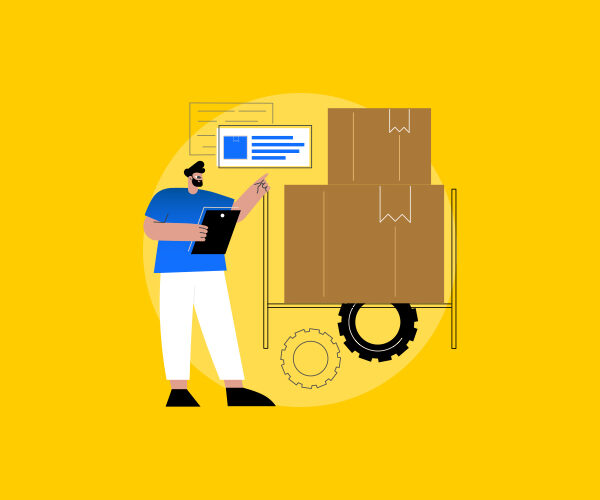Inventory takes up to 20% – 30% of the total business budget. Keeping track of inventory, aka effective inventory management, is the only way to keep a business running and profitable. However, the problem with inventory management is that businesses mostly focus on the products while overlooking the packaging material, which is equally important and necessary. From boxes to pallets and wraps, packaging materials can be of different types based on your products. A proper system to manage these materials is required to prevent stockouts and overstocking.
One common problem among businesses is that they can’t find a proper system to manage packaging inventory. What they don’t realize is that, in addition to having a system, what they need is inventory management software that keeps their inventory in check and under control.
In this blog, we will learn how, as a business, you can manage your packaging inventory to make your business more profitable by reducing stockouts and understocking, which ultimately results in a 10% reduction in your inventory cost.
What is packaging inventory?
Inventory that is needed to protect, store, or transport goods like boxes, wraps, fillers, labels, and cushioning material is known as packing inventory. For a business to run smoothly, careful planning and management of these packaging materials are necessary.

Why must businesses manage their packaging inventory?
Cost:
Packaging is costly. All the boxes and wraps needed to pack your product aren’t free; they cost the business money. Depending on the product type, businesses use different kinds of packaging material, each with its own cost. Even for a single product, there may be more than one type of packaging involved. For example, a single folding carton can cost about $1 per unit, while a corrugated box might range from $2 to $4 per unit. Packaging can consume up to 5% of a manufacturer’s COGS (cost of goods sold).
For companies with large inventories, these costs add up quickly. Even storing a single 4′ x 4′ pallet costs between $16 and $48 each month, depending on whether it’s leased or owned. Therefore, to save cost on packaging material, proper management is more than a need.
Waste:
The second important reason why businesses must have a packaging inventory management system in place is the amount of waste related to packaging material. If not managed properly there could be alot of waste that can impact the environment. In the USA alone, the packaging waste contributes largely to municipal solid waste (MSW). In 2018, the containers and other packing material contributed nearly 28.1% to MSW, that is 82.8 million tons. Among the tons of waste, 40% comprises plastic packaging waste, which is detrimental to the environment.
Stockouts and understocking
Let’s just think about this – It’s Black Friday, orders are rolling in, and suddenly your supply of boxes and wraps falls short. Now you need boxes with your label on them. In this scenario, you either delay those orders or cancel them. That could ruin the whole reason for having a sale during the holiday. Plus, last-minute packing orders can cost you high courier charges and lost sales. That’s why, with proper packing and inventory management, businesses can prevent stockouts and understocking.
How to manage a packaging inventory
1- Understand your packaging needs
First, review your inventory to determine how much packaging, including boxes, labels, and fillers, is needed. Also, consider seasonality, as some seasons are busy with sales while others are slow. Use last 12 months’ order history to spot peak months. Alsp factor in planned promotions and new SKUs.
Make sure to check data from the previous season to get a rough idea of how much packaging will be enough to prevent stockouts or understocking. Additionally, keep a safety stock in case there is a sudden increase in sales.
Safety Stock = (Max daily usage × Max lead time days) – (Average daily usage × Average lead time days)
To save time, automate reorder points (PO creation) to meet your packaging needs;
ROP = Average daily usage × Lead time + Safety stock.
2- Audit and categorize your current stock
Now that you understand your packaging needs, the next step is to audit and categorize your current stock. That you can do in this way;
1. Full Physical Count
First, list all item types: cartons, mailers, void fill, and labels. Also include dimensions, supplier, and unit cost.
2. ABC Classification
The next step is to classify your packaging material into three groups according to where you spend the most, standard, and least. For example;
A: Top 20% of spend (e.g., custom mailers).
B: Next 30% (standard boxes).
C: Bottom 50% (tape, labels).
= 3. Gap Analysis
Next, you need to conduct a gap analysis. With this analysis, you can identify the gap between your current packaging inventory management state and your desired goals. It helps you pinpoint areas that need improvement, determine where to spend less, and identify what requires optimization.
For example;
With this analysis, you can identify items that are frequently out of stock and invest more to meet inventory needs. Similarly, you can also identify over-ordered materials and reduce costs by cutting expenses for those.
3. Select the Right Tracking System
We are talking about managing packaging goods, but which system is best to manage with the minimum possibility of error?
The million-dollar question is: How are we going to track inventory to determine when to order, and how much to order, so we can minimize any particular error that could cause stockouts and understocking?
The answer is with which process we are tracking. Are we using spreadsheets or inventory management software?
Spreadsheet vs. Software
If you are a business with annual spending of less than $50,000, then you might use a spreadsheet to track your inventory, where a dedicated person will physically count and monitor it. But keep in mind that the chances of error are significant.
Next, if you have a large inventory and are still using spreadsheets, the bad news is that your entire tracking system can be prone to errors. A small mistake can cost you millions of dollars.
Therefore, to avoid the risk of losing sales and money, major enterprises and companies use tracking software that automates alerts, batch tracking, and reporting. With inventory management software, you get notified in advance if a certain material is needed in the next week or month. You can also automate ordering and reordering, which can save a lot of time and minimize the chances of human error. To choose which inventory managing system is best look for;
- Real-time alerts on low stock.
- Dashboard for top movers.
- Mobile scanning app.
Barcode & RFID
With a barcode scanner, a company can visually scan labels on products. It can cut counting times by 60% and reduce human error by 43.5%. There are different barcode scanners available in the market. Depending on your requirements and needs, you can select one that suits yours.

The next system utilizes RFID (Radio Frequency Identification), which is ideal for high-volume lines where speed is crucial. In this method, an RFID code is attached to each item, containing information about that product. By simply scanning these codes, you can track stock levels, product locations, and the movement of goods.


5. Optimize storage & workflow
Product placement
To optimize storage, keep fast-moving items close to packing stations and place slow-moving items on higher shelves or in secondary aisles.
Use FIFO for paper-based goods
If your packaging material contains paper and sheets that are susceptible to curling or yellowing, then follow the FIFO method. In FIFO (First In, First Out), you sell the items that were purchased first.

Climate controls
If you want to prevent your packaging material from wasting, make sure to avoid over-storing. Mostly, when you overstore goods, they can get damaged either by seasonal changes (like humidity) or pressure (by keeping material on top of one another). For example, most corrugated boxes can weaken when placed in high humidity for an extended period.
Label everything
For a smooth workflow and supply process, label everything, from small tap boxes to large containers. It will save time and also speed up the process by increasing visibility.
6. Cut waste
Use lean packaging principles
To cut waste and save costs, only order the packaging material that you’ll use in 30–45 days. Also, consolidate orders with one or two trusted suppliers.
Bulk vs. Just-In-Time (JIT)
While ordering, you have two options. Either you can order in bulk or order just in time based on yor needs.
Both methods have their own benefits. With bulk purchasing, companies get a 5-10% discount, while in JIT (Just-In-Time), they keep lower on-hand levels.
Therefore, based on your needs and audit, it’s more practical to order in bulk to cover a specific period. While for seasosn with less predictability you can do JIT.
Sustainability Tie-In
Most businesses focus on minimizing the environmental impact of their packaging practices. Therefore, they are always on the lookout for ways to reduce environmental impact while keeping goods protected and functional.
For example: businesses recycle kraft paper to save 50% on disposal costs or offer “right-size” packaging to cut dimensional weight charges.

7. Measure the right metrics
Monitoring the right metrics can help you evaluate your packaging inventory management:
- Inventory turnover: How fast you use your packaging materials.
- Stockout frequency: How often you run out of essential materials.
- Carrying costs: The total cost of holding inventory, as a percentage of its value.
- Order accuracy: The percentage of orders filled correctly and on time.
- Supplier performance: Delivery timeliness and quality of supplies.
Studies show that using multi-echelon inventory methods can cut safety stock by 17% with traditional techniques, or by 28% when combined with demand sensing.
Next step
Now that you understand how to manage a packaging inventory, the next step is to start practicing it. If you haven’t implemented a tracking system or software, consider doing so. Begin tracking your inventory today, optimize your workflows, reduce waste, and adopt sustainable practices to make a positive impact on the environment.
FAQ
What is packaging inventory?
Inventory needed to protect, store, wrap, or transport goods, such as boxes, wraps, fillers, labels, and cushioning material, is known as packing inventory. For a business to run smoothly, careful planning and management of these packaging materials are necessary.
How often should you audit your packaging inventory?
You can do weekly cycle counts on fast-moving items and a full physical count every 6 months.
How to manage a packaging inventory?
First, understand your packaging needs, use an inventory tracking system to streamline the supply chain, set reorder and safety stock levels, reduce packaging waste, follow sustainability practices, and conduct regular audits to optimize the workflow.



